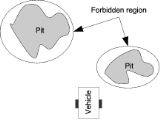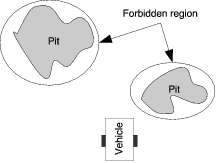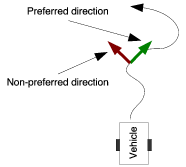
Virtual fixture
Encyclopedia
A virtual fixture is an overlay of abstract sensory information on a workspace in order to improve the telepresence
of a remotely manipulated
task.
abstract sensory information on a workspace in order to improve the
telepresence
in a telemanipulation
task. The concept of abstract
sensory overlays is difficult to visualize and talk about, as a
consequence the virtual fixture metaphor was introduced. To understand
what a virtual fixture is an analogy with a real physical fixture such
as a ruler is often used. A simple task such as drawing a straight
line on a piece of paper on free-hand is a task that most humans are
unable to perform with good accuracy and high speed. However, the use
of a simple device such as a ruler allows the task to be carried out
fast and with good accuracy. The use of a ruler helps the user by
guiding the pen along the ruler reducing the tremor and mental load of
the user, thus increasing the quality of the task.
The definition of virtual fixtures in
(Rosenberg, 1993) is much broader than simply providing
guidance of the end-effector. For example, auditory virtual fixtures
are used to increase the user awareness by providing audio clues that
helps the user by providing multi modal cues for localization of the
end-effector. Rosenberg argues that the success of virtual fixtures is
not only because the user is guided by the fixture, but
that the user experiences a greater presence and better localization
in the remote workspace. However, in the context of
human-machine collaborative systems, the term
virtual fixtures is most often used to refer to a task dependent aid
that guides the user's motion along desired directions while
preventing motion in undesired directions or regions of the
workspace. This is the type of virtual fixtures that is described in this article.
Virtual fixtures can be either guiding virtual fixtures or
forbidden regions virtual fixtures. A forbidden regions virtual fixture could be used, for
example, in a teleoperated
setting where the operator has to drive a
vehicle at a remote site to accomplish an objective. If there are pits
at the remote site which would be harmful for the vehicle to fall into
forbidden regions could be defined at the various pits locations, thus
preventing the operator from issuing commands that would result in the
vehicle ending up in such a pit.
 Such illegal commands could easily be sent by an operator because of,
Such illegal commands could easily be sent by an operator because of,
for instance, delays in the teleoperation
loop, poor telepresence
or
a number of other reasons.
An example of a guiding virtual fixture could be when the vehicle must
follow a certain trajectory,
 The operator is then able to control the progress along the
The operator is then able to control the progress along the
preferred direction while motion along the
non-preferred direction is constrained.
With both forbidden regions and guiding virtual fixtures the
stiffness, or its inverse the compliance, of the fixture can be adjusted. If the
compliance is high (low stiffness) the fixture is soft. On the other hand
when the compliance is zero (maximum stiffness) the fixture is
hard.
fixtures can be derived. It is assumed that the robot is a purely
kinematic device with end-effector position

and end-effector orientation
expressed in the robot's base frame .
.
The input control signal to the
to the
robot is assumed to be a desired end-effector velocity
 .
.
In a tele-operated system it is often useful to
scale the input velocity from the operator, before
before
feeding it to the robot controller. If the input from the user is of
another form such as a force or position it must first be transformed
to an input velocity, by for example scaling or differentiating.
Thus the control signal would be computed from the
would be computed from the
operator's input velocity as:
as:

If there exists a one-to-one mapping between the operator and the slave robot.
there exists a one-to-one mapping between the operator and the slave robot.
If the constant is replaced by a diagonal matrix
is replaced by a diagonal matrix  it is
it is
possible to adjust the compliance independently for different
dimensions of . For example, setting the first three
. For example, setting the first three
elements on the diagonal of to
to  and all other elements to zero
and all other elements to zero
would result in a system that only permits translational motion and not
rotation. This would be an example of a hard virtual fixture that
constrains the motion from to
to
 . If the rest of the elements on the
. If the rest of the elements on the
diagonal were set to a small value, instead of zero, the fixture
would be soft, allowing some motion in the rotational directions.
To express more general constraints assume a time-varying matrix

which represents the preferred direction at time . Thus if
. Thus if  the
the
preferred direction is along a curve in . Likewise,
. Likewise,
 would give preferred directions that span a surface. From
would give preferred directions that span a surface. From  two
two
projection operators can be defined (Marayong et al., 2003), the
span and kernel of the column space:

If does not have full column rank the span can not be computed,
does not have full column rank the span can not be computed,
consequently it is better to compute the span by using the
pseudo-inverse (Marayong et al., 2003), thus in practice the span is computed as:

where denotes the pseudo-inverse of
denotes the pseudo-inverse of  .
.
If the input velocity is split into two components as:

it is possible to rewrite the control law as:

Next introduce a new compliance that effects only the non-preferred
component of the velocity input and write the final control law as:

Telepresence
Telepresence refers to a set of technologies which allow a person to feel as if they were present, to give the appearance of being present, or to have an effect, via telerobotics, at a place other than their true location....
of a remotely manipulated
Telerobotics
Telerobotics is the area of robotics concerned with the control of robots from a distance, chiefly using wireless connections , "tethered" connections, or the Internet...
task.
Concept
The concept of virtual fixtures was first introduced in (Rosenberg, 1993) as an overlay ofabstract sensory information on a workspace in order to improve the
telepresence
Telepresence
Telepresence refers to a set of technologies which allow a person to feel as if they were present, to give the appearance of being present, or to have an effect, via telerobotics, at a place other than their true location....
in a telemanipulation
Telerobotics
Telerobotics is the area of robotics concerned with the control of robots from a distance, chiefly using wireless connections , "tethered" connections, or the Internet...
task. The concept of abstract
sensory overlays is difficult to visualize and talk about, as a
consequence the virtual fixture metaphor was introduced. To understand
what a virtual fixture is an analogy with a real physical fixture such
as a ruler is often used. A simple task such as drawing a straight
line on a piece of paper on free-hand is a task that most humans are
unable to perform with good accuracy and high speed. However, the use
of a simple device such as a ruler allows the task to be carried out
fast and with good accuracy. The use of a ruler helps the user by
guiding the pen along the ruler reducing the tremor and mental load of
the user, thus increasing the quality of the task.
The definition of virtual fixtures in
(Rosenberg, 1993) is much broader than simply providing
guidance of the end-effector. For example, auditory virtual fixtures
are used to increase the user awareness by providing audio clues that
helps the user by providing multi modal cues for localization of the
end-effector. Rosenberg argues that the success of virtual fixtures is
not only because the user is guided by the fixture, but
that the user experiences a greater presence and better localization
in the remote workspace. However, in the context of
human-machine collaborative systems, the term
virtual fixtures is most often used to refer to a task dependent aid
that guides the user's motion along desired directions while
preventing motion in undesired directions or regions of the
workspace. This is the type of virtual fixtures that is described in this article.
Virtual fixtures can be either guiding virtual fixtures or
forbidden regions virtual fixtures. A forbidden regions virtual fixture could be used, for
example, in a teleoperated
Teleoperation
Teleoperation indicates operation of a machine at a distance. It is similar in meaning to the phrase "remote control" but is usually encountered in research, academic and technical environments...
setting where the operator has to drive a
vehicle at a remote site to accomplish an objective. If there are pits
at the remote site which would be harmful for the vehicle to fall into
forbidden regions could be defined at the various pits locations, thus
preventing the operator from issuing commands that would result in the
vehicle ending up in such a pit.

for instance, delays in the teleoperation
Teleoperation
Teleoperation indicates operation of a machine at a distance. It is similar in meaning to the phrase "remote control" but is usually encountered in research, academic and technical environments...
loop, poor telepresence
Telepresence
Telepresence refers to a set of technologies which allow a person to feel as if they were present, to give the appearance of being present, or to have an effect, via telerobotics, at a place other than their true location....
or
a number of other reasons.
An example of a guiding virtual fixture could be when the vehicle must
follow a certain trajectory,

preferred direction while motion along the
non-preferred direction is constrained.
With both forbidden regions and guiding virtual fixtures the
stiffness, or its inverse the compliance, of the fixture can be adjusted. If the
compliance is high (low stiffness) the fixture is soft. On the other hand
when the compliance is zero (maximum stiffness) the fixture is
hard.
Virtual Fixture Control Law
This section describes how a control law that implements virtualfixtures can be derived. It is assumed that the robot is a purely
kinematic device with end-effector position

and end-effector orientation

expressed in the robot's base frame
 .
.The input control signal
 to the
to therobot is assumed to be a desired end-effector velocity
 .
.In a tele-operated system it is often useful to
scale the input velocity from the operator,
 before
beforefeeding it to the robot controller. If the input from the user is of
another form such as a force or position it must first be transformed
to an input velocity, by for example scaling or differentiating.
Thus the control signal
 would be computed from the
would be computed from theoperator's input velocity
 as:
as:
If
 there exists a one-to-one mapping between the operator and the slave robot.
there exists a one-to-one mapping between the operator and the slave robot.If the constant
 is replaced by a diagonal matrix
is replaced by a diagonal matrix  it is
it ispossible to adjust the compliance independently for different
dimensions of
 . For example, setting the first three
. For example, setting the first threeelements on the diagonal of
 to
to  and all other elements to zero
and all other elements to zerowould result in a system that only permits translational motion and not
rotation. This would be an example of a hard virtual fixture that
constrains the motion from
 to
to . If the rest of the elements on the
. If the rest of the elements on thediagonal were set to a small value, instead of zero, the fixture
would be soft, allowing some motion in the rotational directions.
To express more general constraints assume a time-varying matrix

which represents the preferred direction at time
 . Thus if
. Thus if  the
thepreferred direction is along a curve in
 . Likewise,
. Likewise, would give preferred directions that span a surface. From
would give preferred directions that span a surface. From  two
twoprojection operators can be defined (Marayong et al., 2003), the
span and kernel of the column space:

If
 does not have full column rank the span can not be computed,
does not have full column rank the span can not be computed,consequently it is better to compute the span by using the
pseudo-inverse (Marayong et al., 2003), thus in practice the span is computed as:

where
 denotes the pseudo-inverse of
denotes the pseudo-inverse of  .
.If the input velocity is split into two components as:

it is possible to rewrite the control law as:

Next introduce a new compliance that effects only the non-preferred
component of the velocity input and write the final control law as:


